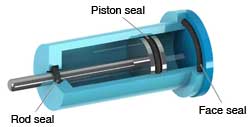
Posted to News on 14th Jul 2011, 07:26
How to specify O-rings for fluid sealing applications
Mick Holland CEng, General Manager of Eriks Sealing Technology, describes how to take advantage of standards when specifying O-rings for fluid sealing applications, and introduces the Eriks O-ring Groove Wizard.

Within the O-ring industry, size references are often referred to as dash sizes. These numbers specify the size and tolerances applied to the toroidal O-ring. Briefly glancing at size reference tables reveals a myriad of apparently random O-ring dimensions that do not appear to conform to any logical pattern. However, there is reason behind these sizes and a basic understanding can help a design engineer specify a seal that minimises costs through the selection of readily available hardware and seal components and by minimising the machining requirements.
Consider the example of designing a hydraulic actuator with a known system pressure and minimum force requirement. From these basic criteria the effective area required of the piston can be determined, hence the minimum cylinder bore diameter can be calculated. Although the the actuator could be modelled with this exact diameter, more experienced engineers may ask, "What size of tube and bar does my metal supplier stock?" The next largest stocked size of metal may then be selected - for example, to give a nominal cylinder bore of 2 inches. When the engineer buys the tube with a 2 inch inner diameter and a bar of 2 inch outer diameter, the bar will never insert into the tube. This is because the metal is sold with a little extra material on to allow the correct machining tolerances to be specified. In our example a nominal bore of 2 inches has been selected; however, the actual dimensions applied to the bore may be 1.992/1.994 and those of the piston 1.988/1.999. A logical nominal groove depth is then applied to the metalwork, namely 1/8inch, for example.
Once the nominal groove dimensions have been determined, a number of criteria are applied to determine the correct size of O-ring:
- Compression (squeeze) - An O-ring of greater cross-section than the radial gap of the groove is installed. This utilises the elastomeric properties of the O-ring to provide an initial reaction (sealing force). The amount of compression applied varies, subject to the type of application (eg static or dynamic).
- Stretch - Although on metal components inner diameters generally have a plus tolerance and outer diameters a minus tolerance, as O-rings are used in numerous types of application they have a plus/minus tolerance. Therefore in piston applications a small permanent stretch is applied and in rod applications a small permanent interference is applied on the outer diameter. This ensures a snap fit to assist with assembly.
- Gland fill - Although initial compression provides a low-pressure seal, pressure energisation of the O-ring is required to maintain the seal at high pressures. To ensure this the groove width must be sufficient to allow pressure into the groove, thereby ensuring that the centre of pressure energises the seal. Standard gland fills are therefore typically below 85 per cent to allow for differential rates of thermal expansion and swelling of the O-ring as media goes into solution within the elastomer.
Correct application of these basic principles is critical for maintaining the integrity of the seal and maximising its life. Furthermore, these basic principles can be applied equally to various scenarios where O-rings may be used, such as rod, piston or face seal grooves, and a number of standards have evolved to assist in specifying seals for standard metalwork dimensions.
Standards
British standards include BS 1806 and BS 4518, which relate to imperial and metric nominal sizes, respectively. Both of these standards offer engineers the freedom to apply their own tolerances to grooves; however BS 1806 does apply low levels of squeeze to small cross-section O-Rings and therefore does not always offer the best sealing arrangement for piston and rod seals. Both of these standards are good for face seal grooves.
The Society of Automotive Engineers in the USA has two standards for piston and rod seals, namely AS5857 and AS4716 for static and dynamic seals. These standards are the most widely used of all and offer comprehensive robust hardware specifications matched to AS568 O-rings.
The International Standards Organisation has published a standard ISO 3601 that also defines grooves in a comprehensive manner. Fortunately, the AS568, BS 1806 and ISO 3601 dash sizes for O-rings correlate; for example, an engineer specifying a -224 O-ring will know the component dimensions will be 1.734 x 0.139 inches for a 2-inch cylinder bore application.
O-ring Groove Wizard
To save design engineers time, Eriks has brought all of these standards together into one easy-to-use online tool. Unlike other tools that enable engineers to design and analyse grooves with a free hand, the simple-to-use tool freely available at oring-groove-wizard.eriks.co.uk [Click on the link 'Find standard groove from a driving diameter' - Ed] rapidly identifies and details suitable standard O-rings and groove dimensions from a given nominal diameter. This tool maximises the chances of specifying a standard seal correctly, thereby optimising the supply chain and manufacturing benefits of engineers' designs. Once the correct dimensions have been identified then the correct material should be specified, based upon thermo-chemical, mechanical and legislative requirements.
Eriks Sealing Technology offers an independent and comprehensive service covering the specification, design, material selection and analysis of O-rings to ensure that the use of these versatile engineering components remains a science, not a black art. Meanwhile, follow the link to try the O-ring Groove Wizard [Click on the link 'Find standard groove from a driving diameter' - Ed].
Want the latest machine building news straight to your inbox? Become a MachineBuilding member for free today >>















